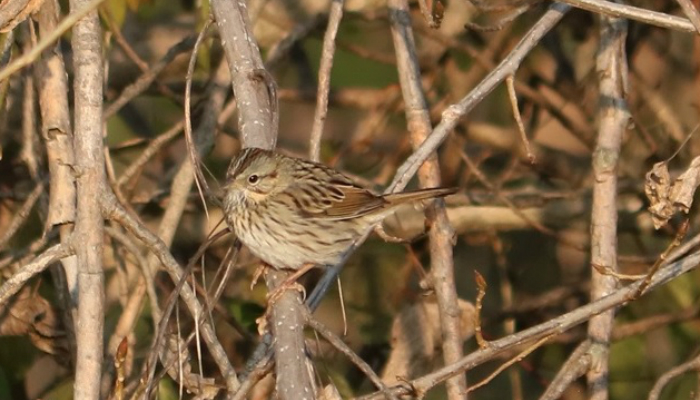The Humble Sparrow

Sparrows, those nondescript little brown birds that are the bane of a casual birder, are both omnipresent and ignored. They are not renowned for beautiful plumage or graceful songs, and in fact are presented as the very embodiment of the common and the lowly–the fall of one sparrow demonstrating the minute and omnipresent attention of God in the Bible, for example.
For too many years, I–not even a casual birder, but more an affectionate observer of birds I happen upon–divided sparrows into “House Sparrows” and “not House Sparrows,” with the former being too ubiquitous for my attention and the latter too vague and difficult to bother with. I would occasionally get photos of a “not House Sparrow” and promptly ignore it as too difficult to identify. Sometimes I would get an easy one–a White-throated Sparrow singing “Oh sweet Canada Canada Canada” was fairly obvious even for me, and the heavily-streaked Song Sparrows were common enough that I grew to recognize them as well–but for the most part these drab little skulkers hopped around beneath my notice.
Two developments over the past year changed my laissez-faire attitude toward sparrows. First was seeing a charming little sparrow on the Greenway last May, hopping up from the pavement to grab beaksful of dandelion seeds. Its strikingly-patterned face–bold black stripes over a white face, with a rufous patch over the ear–was different enough that even I could easily match it to that of the Lark Sparrow in my guide. So not all sparrows were nondescript!
Next came the discovery of websites like iNaturalist, where a casual birdwatcher can upload photos to be identified by those for whom even the most blandly-feathered birds are familiar friends. When my attempts at identification are uncertain, these volunteer experts are prompt and precise in their IDs–putting actual names to all those “not House Sparrows” I encountered along the Greenway, like the sneaky Leconte’s Sparrow last spring, and Lincoln’s and Swamp Sparrows this past October. I could compare my photos to those in both printed bird guides and websites like allaboutbirds.org or audubon.org and then confirm or correct by ID with the help of iNaturalist.
I am making a point to photograph sparrows with as much zeal as I do the flashier birds I encounter, and attempting to put names to their faces. I still have an unfortunate tendency to assume all sparrows are those I am familiar with, and trying to force them into names that don’t quite fit (“gosh, that one looks a little like an American Tree Sparrow, but the beak isn’t right…and something is a little off….” “That’s because it’s a Swamp Sparrow, you goof,” says iNaturalist*). But I’m working on it!
Sparrows are an interesting group of birds, worthy of attention in their own right even if they prove to be challenging. Different species can be seen in our area throughout the year, each with their own life histories and niches to learn about. And there are only around 20 species commonly seen in our area…how hard can it be?**
*Dramatization, may not have happened exactly as described. These online forums are consistently helpful and friendly to anyone trying to learn.
**It’s pretty hard. But worth the effort!
Originally published in Sycamore Greenway Friends.


